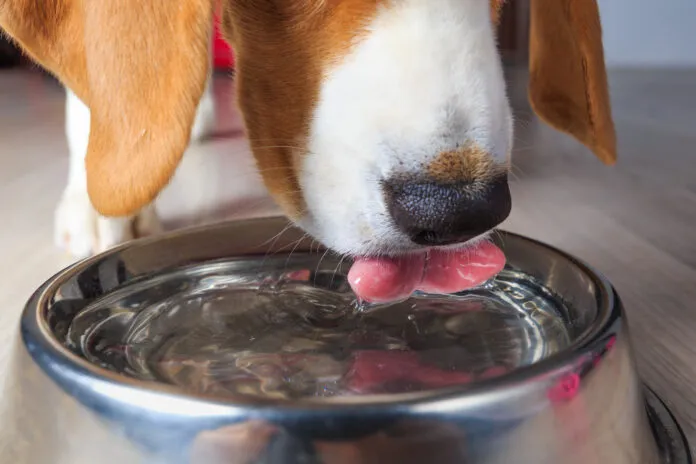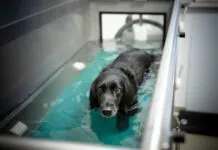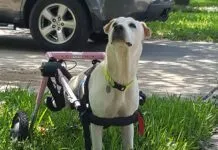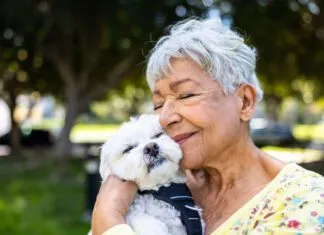There are three general reasons why your dog might not be drinking water: she doesn’t feel good, the available water sources aren’t great, or she is getting water somewhere other than her water bowl.
It is easy to monitor your dog’s water intake, and with a little extra consideration you can figure out if your dog is not drinking enough and a possible reason why.
How Much Water Dogs Need Daily
How much water your dog needs daily will depend on her size, activity level, age, and health status, as well as the environmental conditions and what she is eating. All of these factors are pretty intuitive:
- Larger dogs need more water.
- Active dogs need more water.
- If your dog has an illness that is causing her to vomit, have diarrhea, or pee a lot, she will need more water.
- If it is very warm and/or dry, your dog will need more water.
- If your dog gets a lot of moisture in her meals, she will need less water.
For a good rule of thumb, your dog should drink one ounce of water per pound of body weight each day. For example, a 50-pound dog should drink 50 ounces of water (about one and a half liters).
You can track your dog’s water intake by measuring how much water is in all of her bowls at the start of the day and then seeing what is left at the end of the day. For a more general sense of how much your dog is drinking, keep track of how often you refill her bowls.
Why Your Dog is Not Drinking Water
The three general categories for why your dog might not be drinking water are that she isn’t feeling well, there isn’t quality water available, or she is getting her hydration elsewhere.
Causes related to your dog’s health and well-being:
- Pain in the mouth
- Nausea
- Painful or difficult to bend down to drink due to arthritis or an injury
- Stress
- Anxiety
If your dog doesn’t feel well, regardless of the exact reason, her physical discomfort or emotional distress may override her desire to drink.
Causes related to water sources:
- Dirty water bowl
- Contaminated water
- Water bowl is in an area that your dog doesn’t like, such as at the top of a scary staircase, on slippery flooring, or next to a loud appliance.
- Your dog can’t regularly access the water bowl due to closed doors or baby gates.
- Your dog doesn’t like the material of the bowl (plastic and metal can sometimes give water a funny taste).
Many dogs are perfectly willing to drink out of a slimy or dirty bowl, but others are very particular about water quality. Clean water is critical for your dog’s health, so it is important to clean water bowls frequently and provide fresh water.
Other places dogs may get water/moisture:
- Canned food
- Water added to the regular food during meals
- Toilets
- Pools, streams, or ponds outside
If your dog is getting water somewhere other than her designated water bowl(s), she won’t drink as much. If your dog appears perfectly happy and healthy and has fresh clean water available, observe her throughout the day. You may find that she is getting her water elsewhere.
Why is My Dog Not Drinking Water but Eating?
Many dogs are highly food motivated and will eat even if they are extremely ill or in pain. Water generally isn’t quite as exciting for our canine friends. Your dog also may just not be thirsty.
Why is My Dog Not Drinking Water but Peeing?
Even when your dog isn’t drinking, her body is still producing waste products and flushing them out in urine. Unfortunately, this continued expulsion of water exacerbates dehydration if your dog is not drinking enough.
Signs a Dog Isn’t Getting Enough Water
Dehydration is potentially dangerous and may require veterinary intervention. Signs of dehydration include:
- Lethargy
- Tacky or dry gums
- Excessive drooling
- Poor skin elasticity (if you lift up the skin on your dog’s back, it should snap back into place quickly.)
- Thick saliva
- Poor appetite
- Vomiting
- Diarrhea
- Excessive panting
- Sunken eyes
Vomiting and diarrhea at the same time is an emergency and requires immediate action. Lethargy, tacky gums, sunken eyes, and poor skin elasticity should be addressed promptly, but may be able to wait for regular business hours.
Excessive urination is also a cause for concern and should trigger a vet visit.
Ways to Rehydrate Your Dog
If you are concerned that your dog is dehydrated, start by moving her to a shady or indoor area with good airflow and offer clean, fresh water. You can entice your dog to drink by adding a small amount of low sodium broth to the bowl.
Another trick to encourage your dog to drink is to wet your fingers and then place them on your dog’s tongue. Your dog may be offended at first but sometimes getting that little bit of moisture on the tongue can trigger their desire to drink and makes them realize they are thirsty.
You can also place an ice cube on your dog’s tongue and let it melt (or let her chomp it).
It is possible to “force-feed” water, but this should be done extremely carefully. Add fresh water to a syringe, water bottle, or clean spray bottle. Angle your dog’s head slightly downward and point the syringe or bottle toward your dog’s nose, away from the body. Then squirt small amounts onto the tongue. Taking these precautions prevents your dog from choking or getting water into her trachea and lungs. If she is not swallowing, stop immediately.
If your dog is showing multiple signs of dehydration, she may require veterinary care. Call your veterinarian and describe the symptoms you are seeing, plus what your dog was doing leading up to the onset of symptoms.
At the vet’s office your dog will receive fluid therapy to restore her hydration. Your vet will also do an exam and possibly some diagnostic tests to determine why your dog is dehydrated and any underlying health issues that may require treatment.
Mild cases of dehydration generally get subcutaneous fluids under the skin. A vet or technician will insert a large needle under your dog’s skin and then instill a large amount of fluids. This method is quick and easy, and most dogs tolerate it very well. Your dog will have a temporary bump where the fluids are given, but the liquid will be absorbed into the body over the next few hours.
More severe dehydration may require intravenous (IV) fluids. For this, your dog will have a catheter placed and then have fluids instilled directly into the vein. Your dog will likely stay in the hospital for several hours or overnight so that she can receive a steady flow of fluids over a long period of time. Depending on any other symptoms your dog has, your vet may add electrolytes, vitamins, or medications to the fluids.
How to Get a Dog to Drink More
There are many things you can do at home to encourage your dog to drink more:
- Clean all water bowls regularly.
- Have water available throughout the house and in your dog’s crate—hanging buckets are perfect to prevent spillage in crates and pens.
- Try bowls made of different materials, such as metal, ceramic, or BPA-free plastic.
- Add water to your dog’s meals.
- Keep a fresh bucket or bowl of water in the yard.
- Try a pet fountain to see if your dog likes running water.
- Add a small amount of low-sodium broth to water bowls for flavor and aroma.
- Teach your dog to drink on command by praising and rewarding when she drinks.
- Take drink breaks during summer play sessions.
- Put ice cubes in her bowls for added fun.
- Keep all toilet covers down so your dog isn’t drinking out of the toilet.








